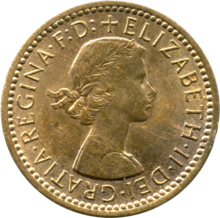
Back Farthing Catalan Farthing (britische Münze) German Farthing (moneda) Spanish Farthing Finnish Farthing French Farthing británico Galician פרד'ינג HE Farthing Italian ファージング Japanese ფართინგი Georgian
United Kingdom | |
| Value | 1/4d sterling |
|---|---|
| Mass | 2.83 g |
| Diameter | 20.19 mm |
| Thickness | 0.666 mm |
| Edge | Plain |
| Composition | Bronze |
| Years of minting | 1860–1956 |
| Obverse | |
 | |
| Design | Elizabeth II |
| Designer | Mary Gillick |
| Design date | 1953 |
| Reverse | |
 | |
| Design | Wren (Britannia on earlier mintages) |
| Designer | Harold Wilson Parker |
| Design date | 1937 |
The British farthing (from Old English fēorðing, from fēorða, a fourth) abbreviated qua. (L. quadrans),[1] was a denomination of sterling coinage worth 1/960 of one pound, 1/48 of one shilling, or 1/4 of one penny; initially minted in copper and then in bronze, which replaced the earlier English farthings. Before Decimal Day in 1971, Britain used the Carolingian monetary system, wherein the largest unit was a pound sterling of 20 shillings, each of 12 pence. Each penny was divided into 4 farthings, thus, a pound sterling contained 960 farthings, and a shilling contained 48 farthings. From 1860 to 1971, the purchasing power of a farthing ranged between 12p and 0.2p in 2017 values.[2]
The farthing coin was legal tender during the reigns of eleven British monarchs: George I, George II, and George III, George IV, William IV, and Victoria, Edward VII and George V, Edward VIII, George VI, and Elizabeth II. In Britain and Northern Ireland the farthing coin ceased to be legal tender on 1 January 1961;[3] however, the farthing remained legal tender in the Falkland Islands, the Falkland Islands Dependencies, and the British Antarctic Territory until 31 October 1970.[4]
In two-and-a-half centuries in circulation as British currency, the reverse face of the farthing coin was minted in two designs: (i) from the 18th century until 1936, the farthing featured the figure of Britannia; and (ii) from 1937, the farthing featured the image of a wren. Like all British coins, the obverse face of the farthing coin bore the portrait of the incumbent monarch.[5]
- ^ "University of Nottingham Manuscripts and Special Collections 'Research Guidance' Weights and Measures § Money". Retrieved 12 March 2014.
- ^ "Purchasing Power of British Pounds from 1270 to Present". measuringworth.com. Retrieved 17 July 2016.
- ^ Cavendish, Richard (12 December 2010). "The Farthing's Last Day". History Today. Retrieved 21 December 2020.
- ^ London Gazette 9 October 1970: "Elizabeth R. We, in exercise of the powers conferred by section 11 of the Coinage Act 1870, do hereby, by and with the advice of Our Privy Council, call in, in the Falkland Islands, the Dependencies of the Falkland Islands and the British Antarctic Territory, all farthings, halfpennies and half-crowns by 31st day of October 1970, and direct that after that date those coins shall not be current or legal tender within those territories."
- ^ Michael, Thomas and Cuhaj, George S. Collecting World Coins: Circulating Issues 1901 - Present (Krause Publications, 2001)
© MMXXIII Rich X Search. We shall prevail. All rights reserved. Rich X Search